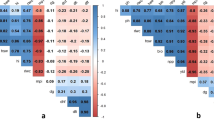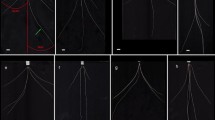Abstract
Extensive and deep root systems have been recognized as one of the most important traits for improving chickpea (Cicer arietinum L.) productivity under progressively receding soil moisture conditions. However, available information on the range of variation for root traits is still limited. Genetic variability for the root traits was investigated using a cylinder culture system during two consecutive growth seasons in the mini-core germplasm collection of ICRISAT plus several wild relatives of chickpea. The largest genetic variability was observed at 35 days after sowing for root length density (RLD) (heritability, h 2 = 0.51 and 0.54) across seasons, and followed by the ratio of plant dry weight to root length density with h 2 of 0.37 and 0.50 for first and second season, respectively. The root growth of chickpea wild relatives was relatively poor compared to C. arietinum, except in case of C. reticulatum. An outstanding genotype, ICC 8261, which had the largest RLD and one of the deepest root system, was identified in chickpea mini-core germplasm collection. The accession ICC 4958 which was previously characterized as a source for drought avoidance in chickpea was confirmed as one with the most prolific and deep root system, although many superior accessions were also identified. The chickpea landraces collected from the Mediterranean and the west Asian region showed a significantly larger RLD than those from the south Asian region. In addition, the landraces originating from central Asia (former Soviet Union), characterized by arid agro-climatic conditions, also showed relatively larger RLD. As these regions are under-represented in the chickpea collection, they might be interesting areas for further germplasm exploration to identify new landraces with large RLD. The information on the genetic variability of chickpea root traits provides valuable baseline knowledge for further progress on the selection and breeding for drought avoidance root traits in chickpea.
Similar content being viewed by others
References
Azhiri-Sigari, T., A. Yamauchi, A. Kamoshita & L.J. Wade, 2000. Genotypic variation in response of rainfed lowland rice to drought and rewatering. Plant Prod Sci 3: 180–188.
Brown, S.C., P.J. Gregory, P.J.M. Cooper & J.D.H. Keatinge, 1989. Root and shoot growth and water use of chickpea (Cicer arietinum) grown in dryland conditions: effect of sowing date and genotype. J Agric Sci (Camb.) 113: 41–49.
Food and Agricultural Organization of the United Nations, 2004. FAO Statistical Databases. Available at http://apps.fao.org/. FAO, Rome.
Gregory, P.J., 1988. Root growth of chickpea, fababean, lentil and pea and effects of water and salt stresses. In: R.J. Summerfield (Ed.), World Crops: cool season food legumes, pp. 857–868. Kluwer Academic publishers, Dortrecht.
Ismail, A. M. & A.E. Hall, 1992. Correlation between water-use efficiency and carbon isotope discrimination in diverse cowpea genotypes and isogenic lines. Crop Sci 32: 7–12.
Kashiwagi, J., L. Krishnamurthy, J.H. Crouch & R. Serraj, 2005. Variability of root characteristics and their contributions to seed yield in chickpea (Cicer arietinum L) under terminal drought stress. Field Crops Res (In press).
Krishnamurthy, L., C. Johansen & O. Ito, 1996. Genetic variation in root system development and its implications for drought resistance in chickpea. In: O. Ito, C. Johansen, J.J. Adu-Gyamfi, K. Katayama, J.V.D.K. Kumar Rao & T.J. Rego (Eds.), Root and nitrogen in cropping systems of the semi-arid tropics, pp. 234–250. Culio Corporation, Tsukuba.
Krishnamurthy, L., C. Johansen & S.C. Sethi, 1999. Investigation of factors determining genotypic differences in seed yield of non-irrigated and irrigated chickpeas using a physiological model of yield determination. J Agronomy & Crop Science 183: 9–17.
Ludlow, M.M. & R.C. Muchow, 1990. Critical evaluation of traits for improving crop yields in water-limited environments. Adv Agron 43: 107–153.
O'Toole, J.C. & W.L. Bland, 1987. Genetic variation in crop plant system. Adv. Agron. 41: 91–145.
Price, A.H., 2002. QTLs for root growth and drought resistance in rice. In: S. Mohan Jain et al. (Eds.), Molecular Techniques in Crop Improvement, pp. 563–584. Kluwer Academic publishers, Boston.
Serraj, R., L. Krishnamurthy, J. Kashiwagi, J. Kumar, S. Chandra & J.H.Crouch, 2004. Variation in root traits of chickpea (Cicer arietinum L.) grown under terminal drought. Field Crops Res 88: 115–127.
Saxena, N.P., 2003. Management of drought in chickpea – A holistic approach. In: N.P. Saxena (Ed.), Management of agricultural drought, pp. 103–122. Oxford & IBH publishing co. Pvt. Ltd., New Delhi.
Saxena, N.P. & C. Johansen, 1990. Chickpea ideotypes for genetic enhancement of yield and yield stability in south Asia. In: Chickpea in the Nineties: Proceedings of the Second International Workshop on Chickpea Improvement, pp. 81–85. 4–8 Dec 1989, ICRISAT Center, Patancheru, A.P. 502324, India. ICRISAT.
Saxena, N.P., L. Krishnamurthy & C. Johansen, 1993. Registration of a drought-resistant chickpea germplasm. Crop Sci 33: 1424.
Subbarao, G.V., C. Johansen, A.E. Slinkard, R.C.N. Rao, N.P. Saxena & Y.S. Chauhan, 1995. Strategies for improving drought resisitance in grain legumes. Crit Rev Plant Sci 14: 469–523.
Turner, N.C., G.C. Wright & K.H.M. Siddique, 2001. Adaptation of grain legumes (pulses) to water limited environments. Adv Agron 71: 193–231.
Upadhyaya, H.D., P.J. Bramel & S. Singh, 2001. Development of a chickpea core subset using geographic distribution and quantitative traits. Crop Sci 41: 206–210.
Upadhyaya, H.D. & R. Ortiz, 2001. A mini core subset for capturing diversity and promoting utilization of chickpea genetic resources in crop improvement. Theor Appl Genet 102: 1292–1298.
Author information
Authors and Affiliations
Corresponding author
Rights and permissions
About this article
Cite this article
Kashiwagi, J., Krishnamurthy, L., Upadhyaya, H.D. et al. Genetic variability of drought-avoidance root traits in the mini-core germplasm collection of chickpea (Cicer arietinum L.).. Euphytica 146, 213–222 (2005). https://doi.org/10.1007/s10681-005-9007-1
Received:
Accepted:
Published:
Issue Date:
DOI: https://doi.org/10.1007/s10681-005-9007-1




